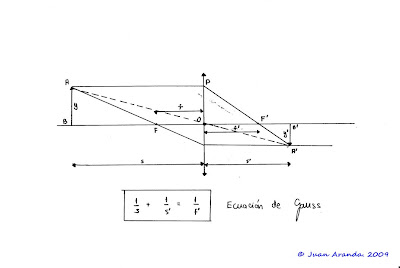Lens focal length approach A close-up lens is a converging lens that fits like a filter in front of goal and mission is to reduce the focal length of the lens.
The optical properties approach a lens measured in diopters. Diopters close-up lens is defined as the inverse of its focal length (measured in meters). So if we have, for example, close-up lens of 4 diopters, focal length will be 1 / 4, ie 0.25 m. Obviamante
This means that the focal length of this lens is 250 mm.
To fully understand the influence of a close-up lens we simplificar un poco y asumir que tanto ésta como el propio objetivo son lentes delgadas. Aunque no es cierto, ésto nos proporcionará unos resultados aproximados.
En el artículo
Fotografía de aproximación: Dispositivos dedujimos que la ratio de reproducción (o aumento lateral) venía dada por la ecuación:
s'
m = ---- - 1 (1)
f
Likewise, Article
effective focal length deduced what the effective focal length of two thin lenses close together. If we call Buddha a lens focal length and focal length fl of the lens approximation, there appear formula can be rewritten as:
Buddha. fefec
fl = --------- (2)
for + fl
From here we will work with a specific case will allow us to understand the nature of close-up lenses. The figure at the beginning of the paper addresses this situation.
The Nikon 50 mm. f1.4 has a minimum focusing distance of 450 mm. Imagine threading a lens approximation of 4 diopters, ie 250 mm.
Suppose we place a particular subject at that distance, ie 450 mm.
From the Gauss equation, conveniently written:
Buddha. s
s' = ----------
s - we need to fo
For s = 450 mm. and for = 50 mm.
50. 450
s' = ---------- = 56.25
450-50
This means that when distance approach s is 450 mm, the image is formed on the sensor to 56.25 mm. the target.
In these circumstances, the reproduction ratio calculated by formula (1) gives: m =
56.25 ------ , - 1 = 0.125
50
This corresponds to a reproduction ratio of 1:8, or whatever it is, the image is 8 times smaller than the subject himself.
If we now place the lens approximation 4 diopters, the situation changes. Why?. For now the effective focal length of the set decreases. Do not you believe it? Let the bills.
; ; 250. 50
By Forumula (2) we must fefec = ------------ = 41.6 mm.
; ; 250 + 50
What influence does this?
If otherwise write the equation of Gauss:
fefec
s = -------- . s'
s' - fefec
we can calculate the value that we could place an object that is the image at the same distance s' ( 56.25 mm) which was when we had not placed the lens approximation. Calculate: 41.6
s = ----------------- . 56.25 = 160 mm (approx.)
56.25 - 41.6
This means that we can place an individual in this position will be the same image which was the original subject at 450 mm. However, and this is important, the target "sees" a virtual subject placed at 450 mm. For him things as if there are close-up lens and the subject was placed at 450 mm. But it is not. This situation can be seen from the diagram that heads this article.
What is the significance of this in the ratio of reproduction? Then calculate:
56.25
The new value of m is m = --------- - 1 = 0350
41.6
This not correspond to a reproduction ratio of (approximately) 1:3. Or what is the same, the subject is 3 times higher than its image.
All this comes to say which is the possibility of bringing the subject to target causing an increase in the rate of reproduction. Of course, for the purpose it is as if the subject was placed much farther from the lens and the reproduction ratio was lower.











